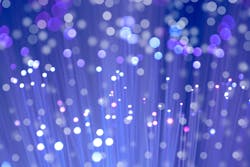As we approach Earth Day on April 22, let’s examine a quiet revolution that has taken place over the last decade in the telecommunications industry, leveraging fiber, Moore’s Law, and commercial-off-the-shelf (COTS) hardware to simultaneously drive down the cost of providing broadband services while reducing energy consumption and increasing reliability. Fiber and its associated technologies are the cornerstone of the next century of telecommunication services, providing a multi-generational framework for delivering more bandwidth at less cost and power than we could have ever imagined when fiber was brought into the first homes in the 1990s.
Transitioning legacy copper and coax networks to fiber would directly reduce carbon emissions by over a million metric tons annually, according to a 2023 estimate by RVA LLC Market Research and Consulting. Fiber’s benefits and simplicity start with its humble medium of glass. Today's glass core, capable of carrying hundreds of terabits of data per second, is created out of silicon dioxide. This abundant and easily accessible material makes up 10% of the earth’s crust. In comparison, copper must be mined and processed into a pure form that requires lots of effort and energy, with deep mines, big trucks, and lots of digging. Copper’s value as a metal makes it a target for theft, a common problem for service provider legacy networks.
An additional benefit is that fiber has demonstrated its durability over time, with the first cables put into service over 50 years ago continuing to be used today through the simple upgrade of the electronics as needed, with each generation of equipment smaller, faster, and more power efficient. The first commercial 400 Mbps optical circuit from Ciena deployed in the mid-1990s took ten full racks of equipment in a central office with its associated power and cooling requirements. Today, Ciena delivers 800 Gbps across a single fiber using a fraction of the power and space of a single 1U shelf and has a clear roadmap to terabyte speeds in the same physical footprint without replacing the existing media.
Similar advancements continue to take place in fiber to the home. The first services deployed in the 1990s offered 100 Mbps, while today’s standard is multi-gig speeds, with some providers offering 25 Gbps speeds. While the industry debates how to get 50 and 100 Gbps speeds to the home, there is an apparent belief and path that 100 Gbps and beyond is easily obtainable by using existing fiber.
Fiber’s sustainability capabilities
Between production and operation over its lifecycle, copper wiring has an 85,000 times higher carbon footprint than fiber. Shutting down legacy copper networks and migrating to all-fiber solutions has become a priority for service providers since it enables them to reduce costs and drastically lower yearly carbon emissions. In 2023, altafiber stated that its network equipment and power generated 56% of its network’s carbon emissions, with an additional 20% coming from cooling its central offices and equipment. The legacy copper network contributed 48% of network equipment's greenhouse gas emissions, making it a prime target for replacement. By 2030, transitioning customers to high-speed fiber from copper will enable altafiber to avoid 14,000 metric tons of greenhouse gas emissions, putting altafiber on a path to achieving Net Zero carbon emissions by 2040.
The reduction in size and cost of telecommunications gear, enabled by advances that include fiber’s tremendous data-carrying capacity, has already led to significant power savings at a critical time in the industry. Legacy copper switching and coax plant and equipment, in some cases dating back to the ‘50s, filled rooms and floors of central offices, drawing significant power for operations and cooling. Copper also doesn’t get along well with water, requiring pressurization systems in many areas to keep things dry. Maintaining and repairing legacy copper throughout the network is a continuing operational expense.
Using fiber in combination with COTS-based server hardware has enabled providers of all sizes to simultaneously reduce their electric bills and free up real estate that can be reused and recycled for other applications. For example, Verizon has consolidated central office operations in downtown New York City as it has shrunk its equipment footprint, freeing up space for offices and even condominiums.
However, those cost savings are noted on more than the monthly electric and water bills. Fiber is a more reliable medium than legacy copper or coax systems, especially when deployed in a PON (Passive Optical Network) architecture that eliminates active access network components. Better reliability by eliminating powered components translates into significantly fewer truck rolls for repairs, providing fiber with a significant and long-lasting operational advantage over legacy copper and existing coax networks, especially when compared to DOCSIS 3.1 and 4.0 networks that introduce additional splitters and amplifiers.
Cable companies have made no secret of their preference for fiber despite their efforts to squeeze more from their existing physical coax plant. Greenfield builds in new markets are all 100% fiber, while competitive “overbuilds” in larger markets are all end-to-end fiber. In the not-too-distant future, the Fiber Broadband Association expects the cable industry to make a larger-scale transition into all-fiber networks for the operational simplicity and cost savings fiber delivers versus trying to squeeze every last penny out of legacy coax cable.
Moving to fiber and reducing carbon emissions is more than a wise business decision—it is a necessity, especially in areas prone to harsh conditions. Climate change events, such as wildfires, hurricanes, tornadoes, and flooding, dramatically impact the operations of telecommunications networks. Fiber’s greater resilience and ease of repair when disaster strikes have made it the obvious choice for operators facing these environmental threats.
AT&T is on a path to becoming carbon neutral by 2025, leveraging its fiber network and other technologies to help businesses reduce carbon emissions by a Gigaton that same year. The company has identified various sectors where it can deploy Smart Climate solutions, with reliable high-speed, low-latency connectivity playing a fundamental role in helping businesses become more efficient by measuring and refining processes for more efficiencies in using electricity, fuel, water, and raw materials. AT&T sees opportunities to drive transportation, industrial production, energy, and agriculture efficiencies, among other sectors.
For example, fiber-connected Smart Grid solutions use renewable energy sources and utility-sized energy storage to reduce oil and gas usage. AT&T is “drinking its champagne” by using its Fleet Solutions to enable insights into the use of its vehicles across the enterprise, helping to reduce fuel use today and generating data for introducing electric cars in the future.
Enabling remote work
However, fiber’s environmental benefits extend far beyond efficiency in data transmission, enabling businesses to be more effective in their daily operations and further reducing carbon emissions. Fiber is the keystone technology that allows the work from home/work from anywhere (WFH/WFA) movement, a revolution taking hundreds of thousands of cars off the roads every day, drastically reducing carbon emissions across the country. In today’s post-pandemic era, WFH continues to be embraced by many companies as a partial or full-time option, resulting in fewer miles driven and less commuting time spent in traffic delays. RVA Market Research and Consulting estimates that WFH reduces carbon dioxide emissions by tens of thousands of kilotons annually, based on real-world data measuring the impact of work from home on gasoline consumption during the pandemic.
Being able to work from anywhere also provides sustainability benefits. Individuals and families can live in less dense rural areas, avoiding commuting miles to congested city centers or having to find housing in urban centers and placing additional burdens on an increasingly aging utility infrastructure. By stemming “rural flight” through enabling WFH, fiber is nurturing small towns and municipalities that previously have lost families and jobs to larger cities.
Today’s transition from legacy copper technologies to fiber in the United States and worldwide will continue to pay sustainability benefits for generations to come through increased reliability, reduced electrical consumption, and as a platform for ever-increasing high-speed, low-latency broadband at continually decreasing pricing. While fiber transmits light across many wavelengths, its green shines brightly for Earth Day.
Gary Bolton is president and CEO of the Fiber Broadband Association — the largest trade association dedicated to all-fiber-optic broadband. Before FBA, Gary held executive management positions at two successful venture-backed high-tech start-ups as well as at large publicly traded companies in marketing, product line management, and public policy. Gary is also an adjunct business administration and management science professor at the University of Alabama in Huntsville. He holds an MBA from Duke University and a BS in Electrical Engineering from North Carolina State University.






